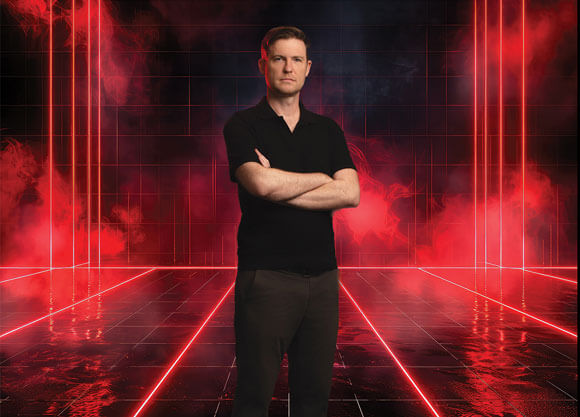
From Hamden to Hollywood
A Q&A with Quinnipiac alumnus Russell Anderson, first assistant editor of Disney's ‘TRON: Ares’
November 17, 2025

November 17, 2025

Back then, a glowing red lightcycle was the furthest thing from his imagination.
Until it wasn’t.
For nearly two years, Anderson worked as a first assistant editor on “TRON: Ares,” the Walt Disney Studios blockbuster released in October. The third film in Disney’s “TRON” series accelerates a clash between humans and artificial intelligence beings.
Anderson worked under contract for Walt Disney Studios in a vintage editorial cutting building on the Disney Studios lot in Burbank, California, not too far from Los Angeles.
“One of the fun things about working on films in LA is you get to go to all the different lots,” said Anderson, who has also worked at Sony Pictures Studios (formerly MGM Studios) where “The Wizard of Oz” was shot.
“It’s really amazing. There’s just so much history here,” Anderson said. “I was taking a walk through the Disney lot and I was like, ‘Oh, they shot ‘Mary Poppins’ on that stage.’ The funny thing is, I was just watching ‘Mary Poppins’ with my daughter.”
Anderson and his wife, Sasha Huff, have a 3-year-old daughter, Eila. Anderson’s brother, Dane, also works in the “family business” as a TV writer.
This interview has been edited for brevity and clarity.
You watch movies as a kid, and you're like, “I want to do that.” You get so influenced by the things you watch and see as a kid. That definitely got me excited about movies. But there’s also the technical side. There’s the magic of being able to manipulate reality. Stop motion was the best early example of that for me. You're hitting stop-start really fast on a consumer camera. You're breaking the laws of physics, and you're seeing a toy animate. It's just incredible.
A first assistant editor is both a technical editor role and a management role. The editor runs the department and supports the director. The two of them work together in real time. When the work starts to overload the editor, or if they want to try something new, that comes to me. I distribute the work to the other assistants, and we do whatever is needed. Maybe we need to add sound design. Maybe we need to comp in temporary assets for a big visual effects scene. It could be almost anything.
I melded the two degrees together. I was doing a lot of different things in school. I wrote Java code. I did after effects and 3D modeling. I was managing edits. I was cutting short films. I was working on the editorial side with graphics. I used 3D Maya for 3D modeling. There was so much going on, but I was really into letting the program be what it needed to be.
So there was this film, “O Brother, Where Art Thou?” It came out in 2000. It’s credited as the first DI (digital intermediate) movie. It was the first time film was ingested into an intermediary format, graded and then spit back out as a print. About four years later, digital cinema cameras started to come out. But the industry moves so slowly. They were like, “Let's just make it work like film. Make it appear indistinguishable from film.” Today, most movies are shot digitally. Film is still in use, but it’s nothing like it once was.
I would say “Jaws” and “Star Wars” inarguably marked the largest pivotal moment in cinema history — maybe since the talkies. It was that transformative for the industry in the ’70s. Those two movies marked the birth of the blockbuster as we know it today. They changed everything with big budgets and special effects.
I’m grateful for the opportunities I’ve had with Disney, Sony, Netflix and all my other projects. I have a lot of friends in the business. I’ve found once you have your network of people, you tend to return to that same group, which is always nice.
Quinnipiac Today is your source for what's happening throughout #BobcatNation. Sign up for our weekly email newsletter to be among the first to know about news, events and members of our Bobcat family who are making a positive difference in our world.
Sign Up Now